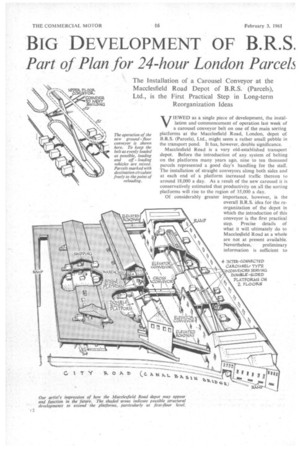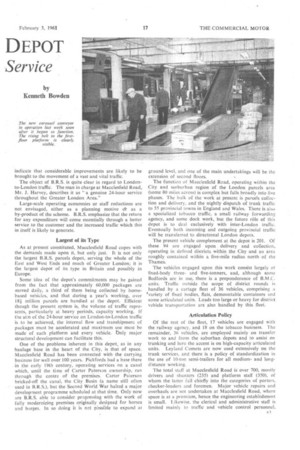• BIG DEVELOPMENT OF B.R.S.
Page 58

Page 59

Page 60

If you've noticed an error in this article please click here to report it so we can fix it.
DEPOT Part of Plan for 24-hour London Parceb
Service
by Kenneth Bowden
The Installation of a Carousel Conveyor at the Macclesfield Road Depot of B.R.S. (Parcels), Ltd., is the First Practical Step in Long-term Reorganization Ideas
VIEWED as a single piece of development, the installation and commencement of operation last week of a carousel conveyor belt on one of the main sorting platforms at the Macclesfield Road, London, depot of B.R.S. (Parcels), Ltd., might seem a rather small pebble in the transport pond. It has, however, double significance.
Macclesfield Road is a very old-established transport depot. Before the introduction of any system of belting on the platforms many years ago, nine to ten thousand parcels represented a good day's handling for the staff. The installation of straight conveyors along both sides and at each end of a platform increased traffic thereon to around 18,000 a day. As a result of the new carousel it is conservatively estimated that productivity on all the sorting platforms will rise to the region of 35,000 a day.
Of considerably greater importance, however, is the overall B.R.S. idea for the reorganization of the depot in which the introduction of this conveyor is the first practical step. Precise details of what it will ultimately do to Macc1e4eld Road as a whole are not at present available.
Nevertheless, preliminary information is sufficient to indicate that considerable improvements are likely to be brought to the movement of a vast and vital traffic.
The object of B.R.S. is quite clear in regard to Londonto-London traffic. The man in charge at Macclesfield Road, Mr. J. Harvey, describes it as "a genuine 24-hour service throughout the Greater London Area."
Large-scale operating economies or staff reductions are not envisaged, either as a planning motive (fr as a by-product of the scheme. B.R.S. emphasize that the return for any expenditure will come essentially through a better service to the customer and the increased traffic which this in itself is likely to generate.
Largest of its Type As at present constituted, Macclesfield Road copes with the demands made uponit, but only just. It is not only the largest B.R.S. parcels depot, serving the whole of the East and West Ends and much of Greater London; it is the largest depot of its type in Britain and possibly in Europe,
Some idea of the depot's commitments may be gained from the fact that approximately 60,000 packages are moved daily, a third of them being collected by homebased vehicles, and that during a year's working, over 181 million parcels are handled at the depot. Efficient though the present system is, the volume of traffic represents, particularly at heavy periods, capacity working. If the aim of the 24-hour service on London-to-London traffic is to be achieved, the internal flow and transhipment of packages must be accelerated and maximum use must be made of each platform and every vehicle. billy major structural development can facilitate this.
One of the problems inherent in this depot, as in any haulage base in the heart of the City, is that of space. Macclesfield Road has been connected withthe carrying business for well over 100 years. Pickfords had a base there in the early 19th century, operating services on a canal which, until the time of Carter Paterson ownership, ran through the centre of the premises. Carter Paterson bricked-off the canal, the City Basin (a name still often used-in B.R.S.), but the Second World War halted a major development programme scheduled at that time. Only now are B.R.S. able to consider progressing with the work of fully modernizing premises originally designed for horses and barges. In so doing it is not pbssible to expand at
ground level, and one of the main undertakings will be the extension of second floors.
The function of Macclesfield Road, operating within the City and surburban region of the London parcels area (some 80 miles across) is complex but falls broadly into five phases. The bulk of the work at present is parcels collection and delivery, and the nightly dispatch of trunk traffic to 55 provincial towns in England and Wales. There is also a specialized tobacco traffic, a small railway forwarding agency, and some dock work, but the future role of this depot is to deal exclusively with inter-London traffic:. Eventually both incoming and outgoing provincial traffic Will be transferred to directional .London depots.
The present vehicle complement at the depot is 201. Of these 94 are engaged upon delivery and collection, operating in defined districts within the City and an area roughly contained within a five-mile radius north of the Thames.
The vehicles engaged upon this work consist largely of fixed-body threeand five-tanners, and, although some Bedfords are in use, there is a preponderance of B.M.C. units. Traffic outside the scope of district rounds is handled by a cartage fleet of 36 vehicles, comprising a °variety of fixed bodies, flats, demountable containers and some articulated units. Loads too large or heavy for district vehicle transportation are also lindled by this .fleet.
Articulation Policy Of the rest of the fleet, 17 vehicles are engaged with the railway agency, and 18 on the tobacco business. The remainder, 36 vehicles, are employed mainly on transfer work to and from the suburban depots and to assist on trunking and here the accent is on high-capacity articulated units. Leyland Comets are now used extensively on the trunk services, and there is a policy, of standardization in the use of 10-ton semi-trailers for all mediumand longdistance working.
The total staff at Macclesfield Road is over 700, mostly drivers and shunters (235) and platform staff (350), of whom the latter fall chiefly into the categories of porters, checker-loaders and foremen. Major vehicle repairs and overhauls are not undertaken at Macclesfield Road, where space is at a premium, hence the engineering establishment is small. Likewise, the clerical and administrative staff is limited mainly to traffic and vehicle control personnel, functions such as accountancy, customer relations, claims, etc., being centralized at City Road.
At the present time the bulk of the Macclesfield Road _traffic is handled by four platforms. Two have an identical function. These are the ground-floor sorting platforms, dealing with incoming vehicles from provincial depots, and most of the depot's London collections, and with a limited amount of traffic carted in by customers. From here traffic goes mainly to the ground-floor local delivery or first-floor provincial dispatch platforms, or is loaded direct for the suburban depots. It is upon one of the sorting platforms that the new carousel " endless " conveyor is now functioning, enabling traffic to circulate freely to the point of loading ----a vital step in the removal of bottlenecks.
The drawings on these pages illustrate how the depot may possibly appear at some time in the future. The main development objectives are the extension of first-floor sorting and delivery platforms; the installation of endless conveyors on these platforms; and the inter-connection of interrelated platforms to accelerate the flow of traffic by reducing as much as possible manual handling and the movement of traffic around the depot by vehicles. Of the two ground-floor sorting platforms, one at present is linked by conveyor with the ground-floor local delivery platform and also by rising belts with the first-floor provincial dispatch platform. The other sorting platform is linked by belt only to the delivery platform, so that the operation here is manual and a large proportion of traffic has to be moved from this platform to other parts of the depot by vehicles.
The upper storey of the delivery platform is to be extended, but will remain by necessity single-sided. It will be connected with its ground-floor counterpart by rising conveyors.
Combined with these basic developments will be the completion of a large basement vehicle park already partly built. Other plans include a new City Road entrance; a new bridge to facilitate one-way first-floor vehicle movement; new vehicle ramping; the introduction of some mechanical handling in the specialized tobacco and docks traffic; and a general modernization of equipment and facilities to go with the new order. When these are completed, B.R.S. should be much nearer their aim of a " 24-hour service" for London-to-London traffic.
































































































































